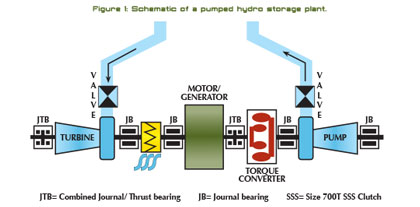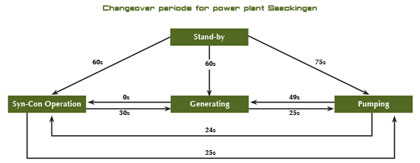As utilities incorporate more wind and solar sources into their generation mix, they are faced with two problems. One is that both wind and solar are highly variable and their peak output doesn’t necessarily line up with peak demand. The other is that they don’t provide the reactive power needed to support the grid. Pumped hydro storage (PHS) is a proven method of balancing production and demand. And, by adding a clutch between the turbine and generator, the PHS plants can also provide the needed grid support not being provided by the renewable power sources.
THE ROLE OF WATER PUMPS
Water pumps can be huge consumers of electricity. Take the example of the California Aqueduct’s Edmonston Pumping Plant. Each of the 65 foot (19 meters) tall, 400 ton (362 tonnes) pumps requires about 60 MW of electricity to drive its 80,000 horsepower motor and lift 315 cubic feet (9 cubic meters) per second of water up 1926 feet (587 meters) to cross the Tehachapi mountains. And that pumping station alone has fourteen such pumps.
But water pumps can also play a huge role in stabilizing the grid and evening out power generation and consumption. Pumped hydro energy storage involves using massive pumps, when there is excess generation and electricity costs are low, to move water uphill to a reservoir. Then when demand is high, the water flows back downhill through a turbine to generate electricity.
As renewable portfolio standards increase, the question is how to balance output and demand when much of the electricity is being generated by highly-variable wind and solar stations that operate on nature’s schedules, not the markets. While new technologies such as massive battery packs and supercapacitors have hit the market, a proven, economical and efficient method is to use pumped hydro storage. Originally developed to allow large nuclear and fossil plants to operate at full capacity around the clock, the technology can also be used to smooth out the fluctuations from renewable generation sources.

THE NEED FOR BALANCE
For a variety of economic, environmental, and public relations purposes, utilities around the world have been installing huge quantities of renewable energy. According to the World Wind Energy Association, in 2012 hydropower accounted for 16.5 percent of the global electricity production and other renewables accounted for another 5.2 percent. Global wind power capacity had grown more than nine-fold over the past decade, from 31,000 MW in 2002 to 283,000 MW in 2012, with a third of that capacity installed in the previous two years. Solar has seen similar growth rates. According to a September report from Bloomberg New Energy Finance, 36,700 MW of solar photovoltaic power will be installed this year, surpassing new wind power installations for the first time.
The problem with wind and solar, however, is that their output cannot be scheduled to meet demand. In certain areas, such as the deserts of the Southwestern United States or the Arabian Peninsula, peak solar production does coincide with the demand for afternoon air conditioning. Other areas aren’t so lucky. As German magazine Der Spiegel reported in January 2012, “As is so often the case in winter, all solar panels more or less stopped generating electricity at the same time. To avert power shortages, Germany currently has to import large amounts of electricity generated at nuclear power plants in France and the Czech Republic.” But, in August 2013, the German solar panels generated a record 5.1 Terawatt hours of electricity. Looking at wind power, many areas, output tends to be highest at night and highest in winter, when demand is lowest.
THE RIGHT MIX TO MEET DEMAND
Now, if it were simply a matter of balancing summer and winter or day and night power generation, it wouldn’t be much of a problem; fossil or hydropower could be scheduled ahead of time to compensate. But in reality wind and solar can fluctuate minute by minute. A cloud moving across a solar panel can instantly cut its output by more than half, and wind tends to be gusty rather than steady. The California Independent System Operator (CAISO), which operates the power grid in that state, demonstrated through their research how a mix of fossil, wind, and solar generation sources could smoothly ramp up and down during the day to meet changes in output and demand. However, that is an ideal scenario, and we don’t live in an ideal world. In the real world, wind and solar output don’t follow smooth curves, but swing wildly.
As a CAISO senior advisor for market and infrastructure told a conference, CAISO can lose 500MW in five minutes due to clouds or wind changes. The big challenge is balancing wind and solar in real time due to sub hourly variations.
Although new gas turbines have come out in the last few years that can start in under ten minutes in order to compensate for sudden drops in output, much research is being done on developing methods to efficiently store excess electricity until it is needed. The U.S. Department of Energy’s Sandia National Laboratories maintains an International Energy Storage Database (see www.energystoragexchange.org) that lists fifty different types of energy storage in use at more than 400 locations around the world. Some of these are small battery-storage installations that can provide a little emergency backup in the event of a blackout, but at the top of the list are more than 150 power plants using pumped hydro energy storage to deliver up to 3000 MW of power for ten hours straight.
Not only can pumped hydro serve to smooth out the fluctuations of renewable energy, but make it possible for a utility to run its lowest cost and most efficient power plants at full capacity around the clock, instead of having to turn them down over night. With the right design, a pumped hydro plant can also help stabilize the grid even when it is not generating power, allowing more power to be transmitted over a line and reducing the risk of blackouts. Let’s look at two long-running plants in southern Germany to see how they operate.

PUMPED HYDRO IN SOUTHERN GERMANY
In the 1960s, Schluchseewerk AG’s Hotzenwald Group started construction on two pumped hydro storage plants in Southern Germany. The first is the Säckingen power station located near the Rhine River in Bad Säckingen, which began construction in 1961 and was commissioned in 1967. The following year, Schluchseewerk began building a second and larger pumped hydro station about 6 miles (10 kilometers) away in Wehr. In addition to using pumped water from the Rhine, both reservoirs also collect water from rain and snowmelt to use for power generation electricity, reducing the amount of electricity required for pumping.
The Säckingen power station is built in a man-made cavern that is 525 feet (160 meters) long, 75 feet (23 meters) high, and 108 feet (33 meters) high. Access to the equipment room is through a 5000 foot (1.5 kilometer) tunnel. The plant takes water from the Rhine River and pumps it to the Eggberg Reservoir, about 1300 feet (400 meters) above the plant.
Inside the machine room are four pumping-generating units with a pump on one side, the motor/generator (M/G) in the middle and a Francis water turbine on the other. The two-stage Voith pumps were based on a design that had proven itself successful at a pumped hydro storage plant upstream from Säckingen on Lake Constance (Bodensee). These have 85 inch (2173 millimeter) diameter impellers, each of which consists of one traversing ring and one volute. The impellers are mounted back-to-back on the shaft, which allows the axial thrust of the two stages to balance each other so only a small thrust bearing is needed. This design also had a lower gap leakage than conventional two-stage pumps of that era, and achieved efficiency of about 92 percent. Each 70.7 MW pump can move 4266 gallons (16,150 liters) of water per second up to the Eggberg Reservoir. Low-pressure flow is controlled by a 60 inch (1.6 meter) spherical valve and high-pressure by a 55 inch (1.4 meter) spherical valve. In 1994, one of the pumps was replaced with a larger, 89.3 MW pump with a 113 inch (2880 millimeter) impeller that can pump 5626 gallons (21,300 liters) per second. Each pump is driven by a 176 ton (160 tonne), 118 MVA motor/generator. Two of these were built by Brown Boveri and Cie and the other two by AEG-Telefunken. The pumps are not blown down, but remain filled, with a Voith-Föttinger-type torque converter used to start the pump. Once the pump is up to near synchronous speed, a gear clutch joins the pump to the motor and the water is drained from the converter.
When there is a demand for electricity, the unit switches from pumping to generation. The pump is disconnected from the motor/generator and the water flows down from the Eggberg Reservoir into an Escher Wyss Francis turbine attached to the other side of the motor/generator. Each turbine can produce 90 MW at 600 rpm given a 1332 feet (406 meter) head and a flow of 6472 gallons (24,500 liters) per second.
Between the turbine and the M/G is a self-synchronizing clutch based on a design from SSS Gears Ltd. and manufactured by Renk. The Size 700T SSS clutches have an outside diameter of 67 inches (1700 millimeters), a flange length of 35 inches (900 millimeters) and weigh, with casing, about 7 tons (6 tonnes). The clutch automatically engages as soon as the water turbine speed exceeds that of the M/G and disengages when the turbine starts to slow down. The SSS clutch allows the turbine to accelerate at 100 rpm/s, reaching full speed in six seconds. If the M/G is already at synchronous speed, it usually takes about 30 seconds before it can be loaded. If the turbine and M/G are both at a standstill, it takes about 60 seconds to get up to synchronization.
Schluchseewerk took the same approach when it built its pumped storage plant in Wehr. The new plant also had four pump-M/G-turbine units, but this time there is a 2067 foot (630 meter) elevation differential between the lower Wehra Reservoir and the upper Hornberg Reservoir, and the total power output is 910 MW instead of 360MW.
Once again, Voith provided the pumps: 250MW pumps with 105/66 inches (2670/1680 millimeters) impeller diameters and 9510 gallons (36,000 liters) per second flow rates. AEG-Telefunken provided the 391 ton (355 tonne), 300 MVA M/Gs, and Escher Wyss the 248MW, 106 inch (2685 millimeter) diameter, 11,888 gallons (45,000 liters) per second Francis turbines. The equipment is installed in a 720 foot (219 meter) long cavern that is 35 meters (115 feet) high and 19 meters (62 feet) wide. A torque converter is installed between the pump and the M/G and an SSS clutch between the turbine and the M/G.
THREE MODES OF OPERATION
Pumped storage machinery can be arranged with either vertical or horizontal shaft lines. Horizontal machines that have a radial turbine and radial pump either side of a generator have only one direction of rotation. Reverse rotation can occur if the valves fail to shut properly, however this is abnormal. In a simple vertical plant with a radial turbine, the turbine is reversed (to become a pump) in order to shift from generation to pumping mode. SSS clutches are most likely to be used with horizontal machinery trains, although they can also be used with vertical arrangements.
Horizontal designs with SSS clutches, because they allow for single-direction rotation at PHS plants, greatly reduce the changeover period between pumping and generating modes, giving additional flexibility for evening out the production of highly variable wind and solar generation.
Finally, the addition of an SSS clutch to a horizontally arranged PHS machine allows the motor to run freely without losses (aside from bearing friction, which is relatively low anyway) and thus provide synchronous condensing support. A spinning generator also adds electrical inertia to the local grid, something which static VAR compensators cannot. This is particularly important in areas that rely on large scale wind and solar farms for generating capacity, but which do not provide the MVars needed for grid stability.
This is the approach taken at both the Säckingen and Wehr plants where using SSS clutches allows Schluchseewerk to operate its plants in three modes.
When sending water to the reservoir, the pump is connected to the M/G and the turbine is disconnected. If the turbine was hard-coupled to the M/G, when the turbine was not in operation, part of the M/G’s power would go to keeping the turbine spinning instead of it all going toward driving the pump. To reduce the load, the water would need to be drained from the turbine, lengthening the time it takes to switch between generation and pumping. With the clutch, both the turbine and the pump can remain full at all times. In addition, there is less wear on the turbine seals, bearings and bushings since the turbine is not continually spinning when not needed.
The second mode is generation, when the turbine drives the M/G and the pump is disconnected. Since the SSS clutch allows the turbine and M/G to synchronize at any speed, the switchover is fast and smooth.
But there is a third operating state, when neither pumping nor generation is required. In this case, both the pump and the turbine can be disconnected from the M/G. The M/G can stay connected to the grid and synchronized to it, providing what is known as “reactive power” a key element of grid stability.
By using pumped hydro storage, and configuring the plants to also provide reactive power, not only can utilities even out the fluctuations caused by adding renewables to the mix, but can boost the stability of their grid. And, as the two Schluchseewerk plants that have been operating continuously for more than forty years demonstrate, this configuration delivers long term reliability. ■
_________________________________________________________________________
ABOUT THE AUTHOR
Joe Zwers is a freelance writer from Glendale, California, specializing in technology, business, and engineering.
_________________________________________________________________________
MODERN PUMPING TODAY, December 2013
Did you enjoy this article?
Subscribe to the FREE Digital Edition of Modern Pumping Today Magazine!
![]()


